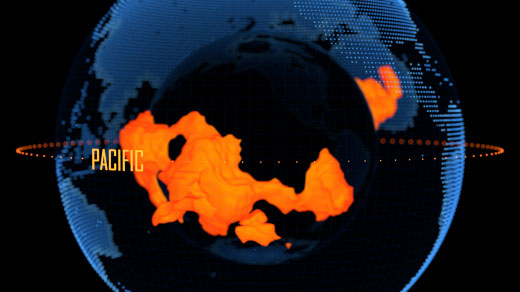A Massive Subterranean ‘Tree’ Is Moving Magma to Earth’s Surface
Introduction
Réunion, a French island in the western Indian Ocean, is like a marshmallow hovering above the business end of a blowtorch. It sits above one of Earth’s mantle plumes — a tower of superheated rock that ascends from the deep mantle and flambés the bases of tectonic plates, the jigsaw pieces that make up the ever-changing face of the world. The plume’s effects are hard to miss: One of the island’s two massive volcanoes, the aptly named Piton de la Fournaise or “peak of the furnace,” is one of the most hyperactive volcanoes on the planet.
But the plume’s modern-day punch is nothing compared to its past.
Around 65 million years ago, when the plume was under what is now India, a series of lava floods named the Deccan Traps smothered 1.5 million square kilometers of land — enough to bury Texas, California and Montana — in a mere 700,000 years, a geologic heartbeat. A giant asteroid strike would be the coup de grâce for the dinosaurs, but the Deccan Traps have long muddled the picture of the climatic conditions the dinosaurs had to contend with.
In 2012, a team of geophysicists and seismologists set out to map the plume, deploying a giant network of seismometers across the vast depths of the Indian Ocean seafloor. Nearly a decade later, the team has revealed that the mantle is stranger than expected. The team reported in June in Nature Geoscience that the plume isn’t a simple column. Instead, a titanic mantle plume “tree” rises from the fringes of the planet’s molten heart, with superheated branchlike structures appearing to grow diagonally out of it. As these branches approach the crust, they seem to sprout smaller, vertically rising branches — super hot plumes that underlie known volcanic hot spots at the surface.
The discovery of this massive structure beneath Réunion nearly coincides with another recent discovery, reported in November, that found additional structures in the plumes under Africa. Taken together, the two findings represent a significant scientific advance: They suggest that plumes can be more idiosyncratic, and can have more elaborate backstories, than traditional models presumed.
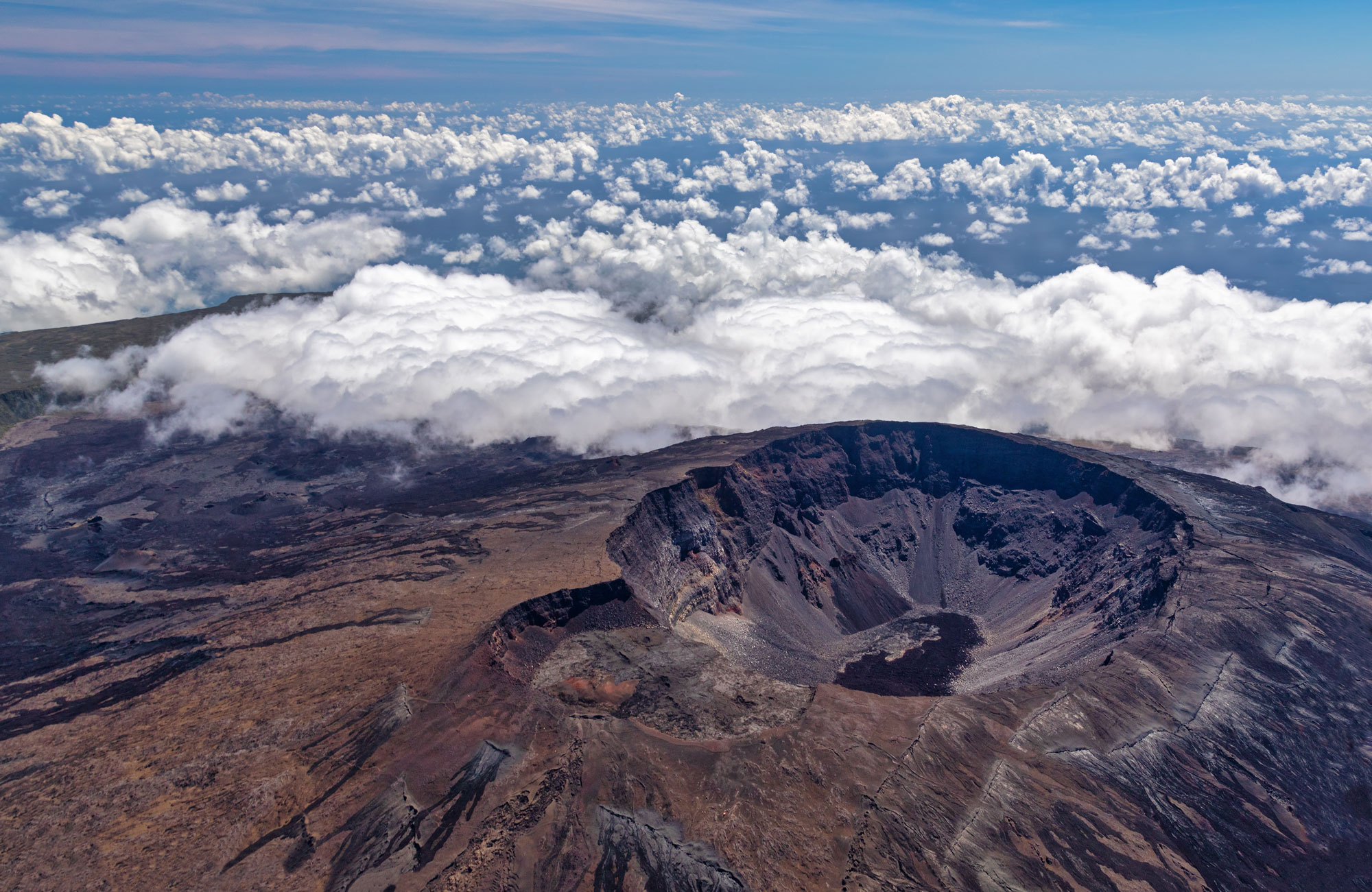
The caldera of the Piton de la Fournaise on Réunion.
The Réunion tree’s root, which researchers already knew about from prior work, is likely a primordial object, perhaps almost as old as Earth itself. So it is possible this torrid tree has been growing its canopy of plumes for billions of years. Presuming that more branches continue to grow, scientists now have a window into Earth’s fiery future.
“From looking at the core-mantle boundary, you can maybe predict where the oceans will open,” said study co-author Karin Sigloch. Researchers can also forecast the land that will one day be obliterated. If the new models are accurate, a few tens of millions of years from now, you may not want to be in South Africa — or, perhaps, on planet Earth at all.
Fountains of Fire
Back in the 1960s, when the theory of plate tectonics was rapidly gaining acceptance, certain geological features seemed to evade explanation. While the theory provided explanations for questions that had long puzzled scientists — where volcanoes appear, where land is born, where ocean basins are carved out, where ancient crust was annihilated — it couldn’t explain something like Hawai‘i.
Plate tectonics predicts that the boundaries of tectonic plates — where two plates collide, slide over or under one another, grind side by side, or move apart — are where most of the planet’s geologic fireworks can be found. The so-called Ring of Fire, the horseshoe-shaped region that marks the fringes of the many plates surrounding the Pacific plate, is home to 75% of the world’s active volcanoes.
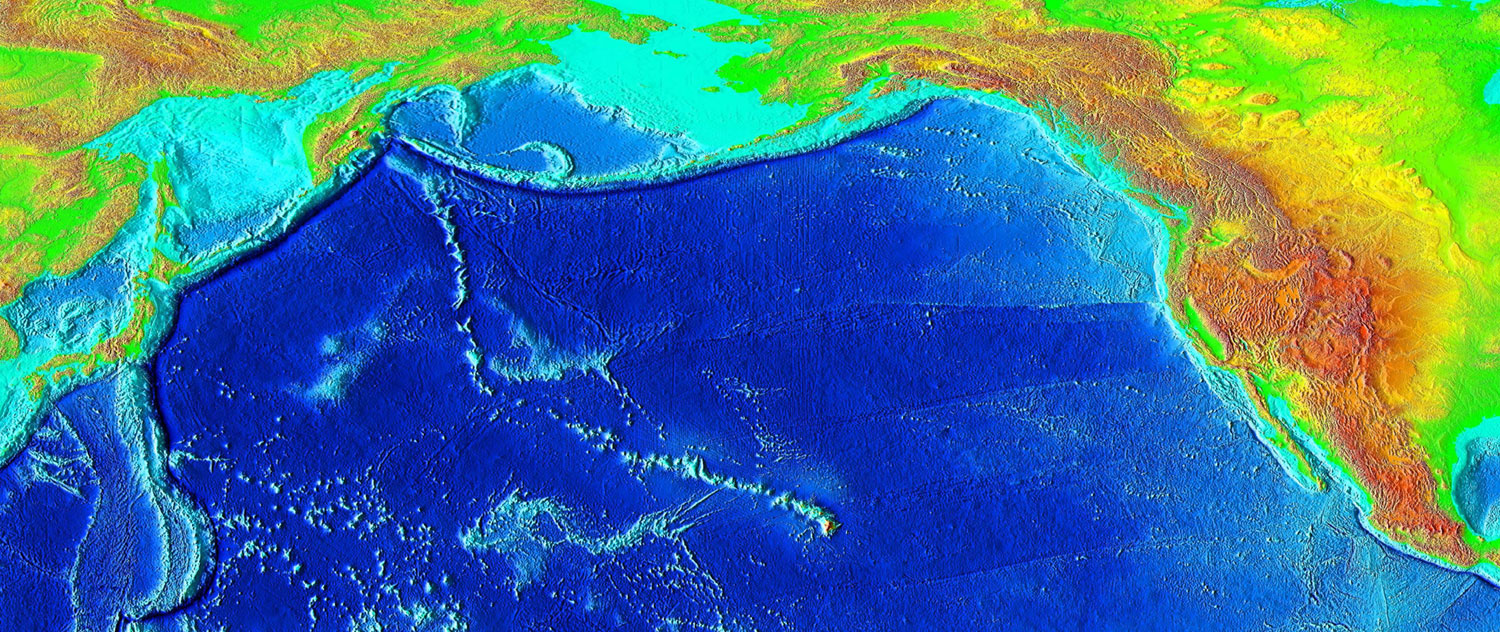
The Hawai‘i–Emperor seamount chain is a series of mostly underwater volcanoes, many dormant, that stretch more than 6,000 kilometers across the Pacific Ocean.
But despite being nowhere near a plate boundary, Hawai‘i is an archipelago of giant volcanoes. The active submarine volcano Lō‘ihi, off the southeastern shore of the island of Hawai‘i, is the youngest member of a warped chain of volcanoes 6,000 kilometers long, one that can be traced all the way to long-expired underwater volcanoes in the northwest Pacific. This phenomenon, known as intraplate volcanism, stood out as a geologic aberration.
In 1963, the Canadian geophysicist John Tuzo Wilson suggested that volcanic chains like this are forged when a tectonic plate continuously drifts over a stationary hot spot in the mantle — the scorching rock that makes up 84% of Earth’s volume. This creates a sequence of volcanoes that erupt, grow, then die out as the plate migrates away from the magmatic fuel source. In 1971, the American geophysicist William Jason Morgan proposed that these hot spots were caused by plumes of particularly hot material rising from the lower mantle.
Over the following decades, geophysicists concluded that plumes are around 200 degrees Celsius hotter than the ambient mantle. When plumes reach the base of tectonic plates, their heat melts their surroundings, making plenty of magma. The plumes also carry mantle material up from Earth’s depths. This material melts at the lower pressures found away from the core, feeding additional magma into the crust. The combined supply of hot magma neatly explains a great number of Earth’s intraplate volcanoes.
Chains of volcanoes, also known as hot spot tracks, are difficult to explain without invoking plumes. Hawai‘i is an oceanic example, but they can be found on land, too: The Yellowstone supervolcano is the youngest member of a hot spot track dating back at least 17 million years, one that poured 210,000 cubic kilometers of lava across the Pacific Northwest before blasting out a trail of giant volcanic cauldrons from Oregon to Wyoming — the undeniable scar tissue of an unrelenting mantle plume.
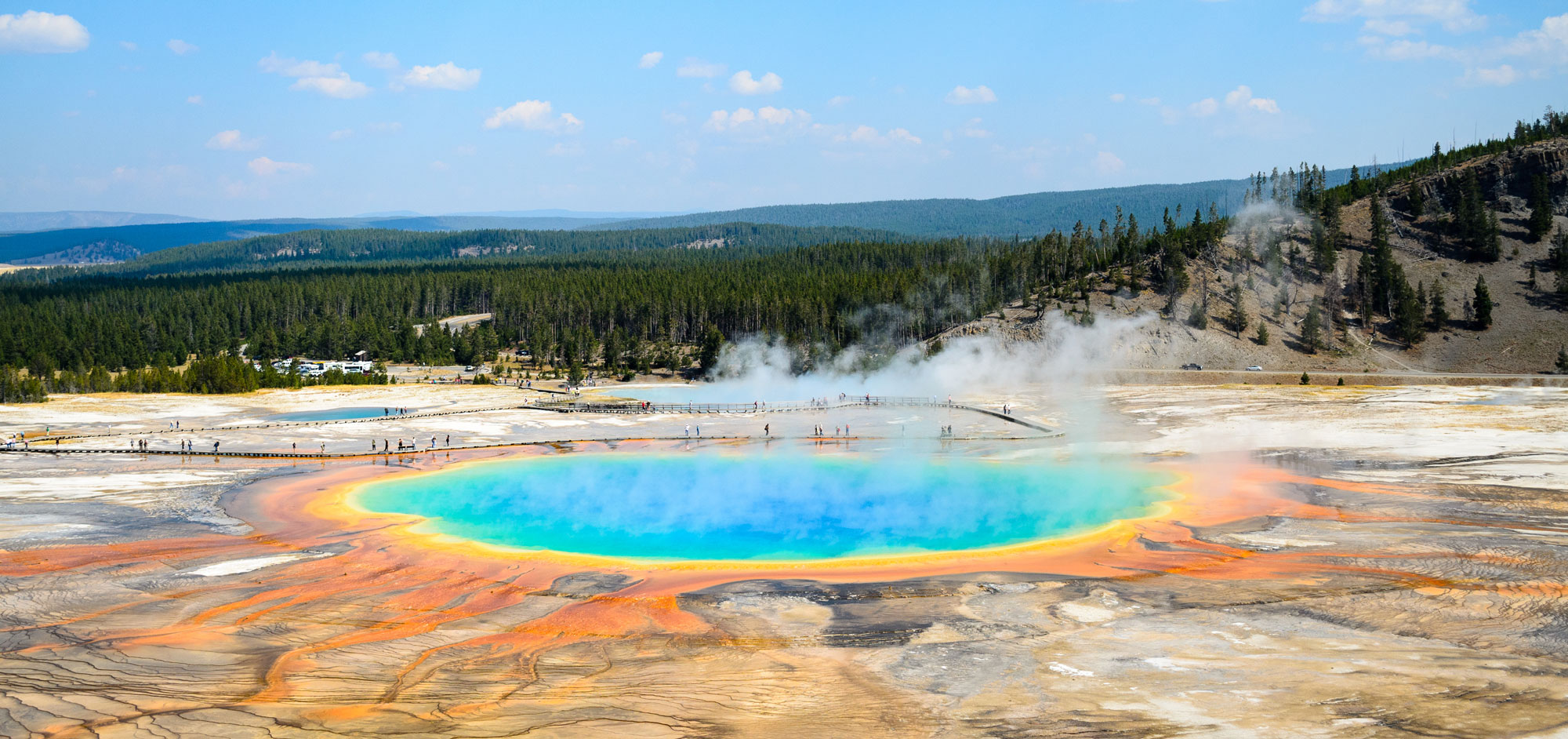
Heat from a mantle plume powers thermal features such as this one in Yellowstone National Park.
Chemical evidence also implies the existence of mantle plumes. There are two stable types of helium: helium-3 and helium-4. Helium-3 was trapped deep within Earth during its formation and is decidedly ancient. Several hot spot volcanoes, including Hawai‘i’s Kīlauea, erupt lavas with an abundance of the stuff. That, said Godfrey Fitton, a petrologist at the University of Edinburgh, suggests that these volcanoes are mining mantle matter from considerable depth — and a plume is a reasonable explanation.
Seismic Scenes
No eyes have ever directly seen a plume; they are inferred to exist. But researchers have gathered considerable evidence in their favor.
Seismic waves have provided revelatory validation. They emanate from earthquakes that dive through Earth’s viscera before curving back toward the surface. As these waves travel, the geologic bodies they pass through alter their speed and trajectory. Seismometers pick up this information, and scientists use the data to try and work out what is hiding within that great abyss.
Seismic waves move more slowly through hot rock, and study after study has shown that they often slow down through elongate structures that rise from the deep mantle and connect with volcanic hot spots at the surface.
Seismologists have also discovered two giant blobs of material — one beneath Africa, the other below the Pacific — that sit astride the boundary between the mantle and the core. Deep-diving waves decelerate as they move through both giant blobs, suggesting that they are hot colossi, together covering about 30% of the entire core-mantle boundary.
The duo have all manner of possible origin stories, ranging from a graveyard of defunct tectonic plate slabs to the dissected corpse of Theia, the protoplanet that collided with the infant Earth and manufactured the Moon. With some exceptions — Yellowstone among them — Earth’s plumes seem rooted to one of those two giant blobs, said Saskia Goes, a geophysicist at Imperial College London. This suggests they play a role in most plumes’ origin stories.
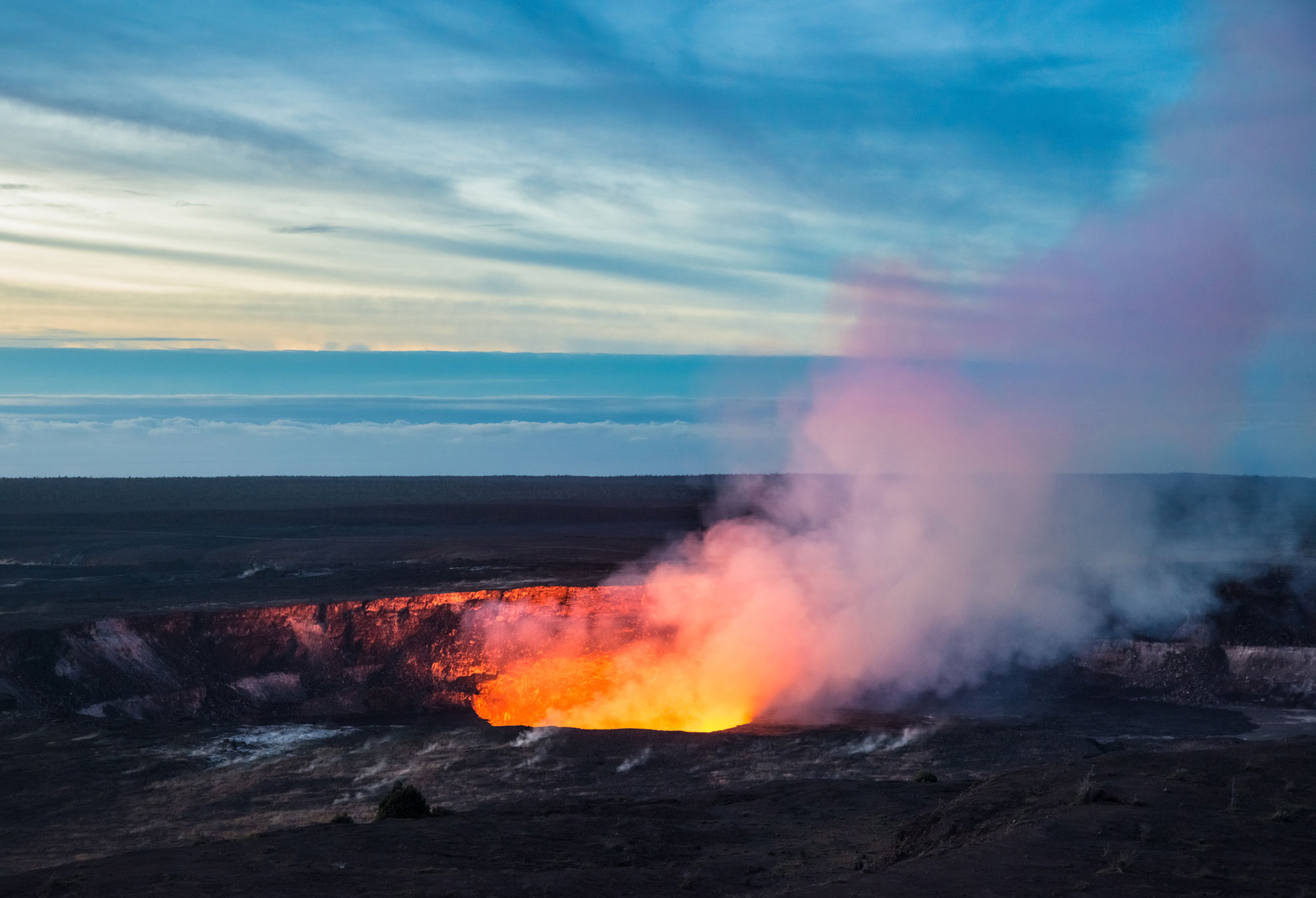
The Pu‘u‘ō‘ō eruption on Hawai‘i’s Kīlauea Volcano lasted 35 years.
But seismology is not omniscient. Seismic waves can detect structures within the mantle, but they cannot reveal every characteristic of those structures. “You can slow down a seismic wave by heating a material up,” said Harriet Lau, a geophysicist at the University of California, Berkeley. But a change in the rock’s mineral makeup can achieve the same effect. Scientists are forced to choose which option is more likely in each measurement they do. Seismology may be a hard science, but there is an art to it.
Subcrustal structures are also equipped with camouflage. Seismic waves like to take the fast lane: They preferentially channel into colder, rigid rock. Plumes, being hot, are repulsive to seismic waves. Plumes are also thin, allowing most incoming seismic waves to dodge them with ease.
The more seismic waves you have crossing through the same point in the plume, the more confident you can be that it exists. But “earthquakes don’t happen everywhere,” said Catherine Rychert, a geophysicist at the University of Southampton. And seismic stations are mostly on land, not on the seafloor, which means oceans have poor seismic coverage.
“Theoretically, we know [plumes] have to exist,” said Lau. “But they’re just so hard to see seismically.” Consequently, seismic waves capture only slices of plumes, and their properties are often the subject of unresolvable debate.
Ideally, scientists want to produce a plume image that stretches from its base to the planet’s surface. That would require a cornucopia of seismometers spread over a vast area, forming a huge aperture that could eat up as many seismic waves as possible and thereby see a sizable segment of the mantle — a seismic equivalent of a giant telescope.
So, in 2012, scientists built one.
The Tree and the Truth
That year, two vessels zigzagged across the western Indian Ocean, occasionally stopping to make a submarine seismometer walk the plank and sink to the seafloor. In total, 57 were thrown overboard, ultimately creating a 2,000-by-2,000-kilometer aperture. This vast array was augmented by 37 seismic stations positioned on Madagascar and various smaller islands.
For 13 months between 2012 and 2013, that aperture was open. Its objective: to hunt down the Réunion plume, one of the most consequential fountains of fire to grace the planet in the past 100 million years.
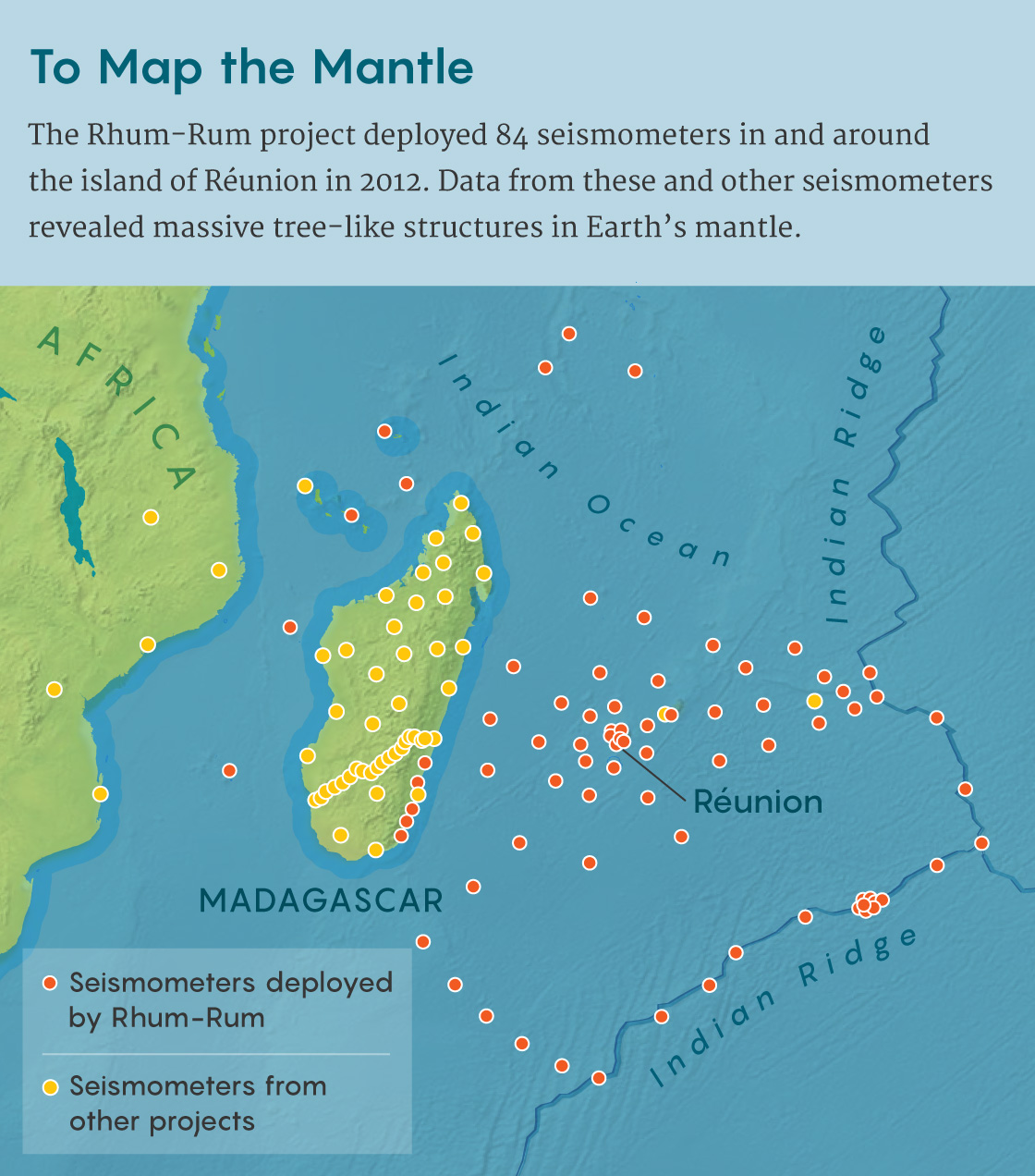
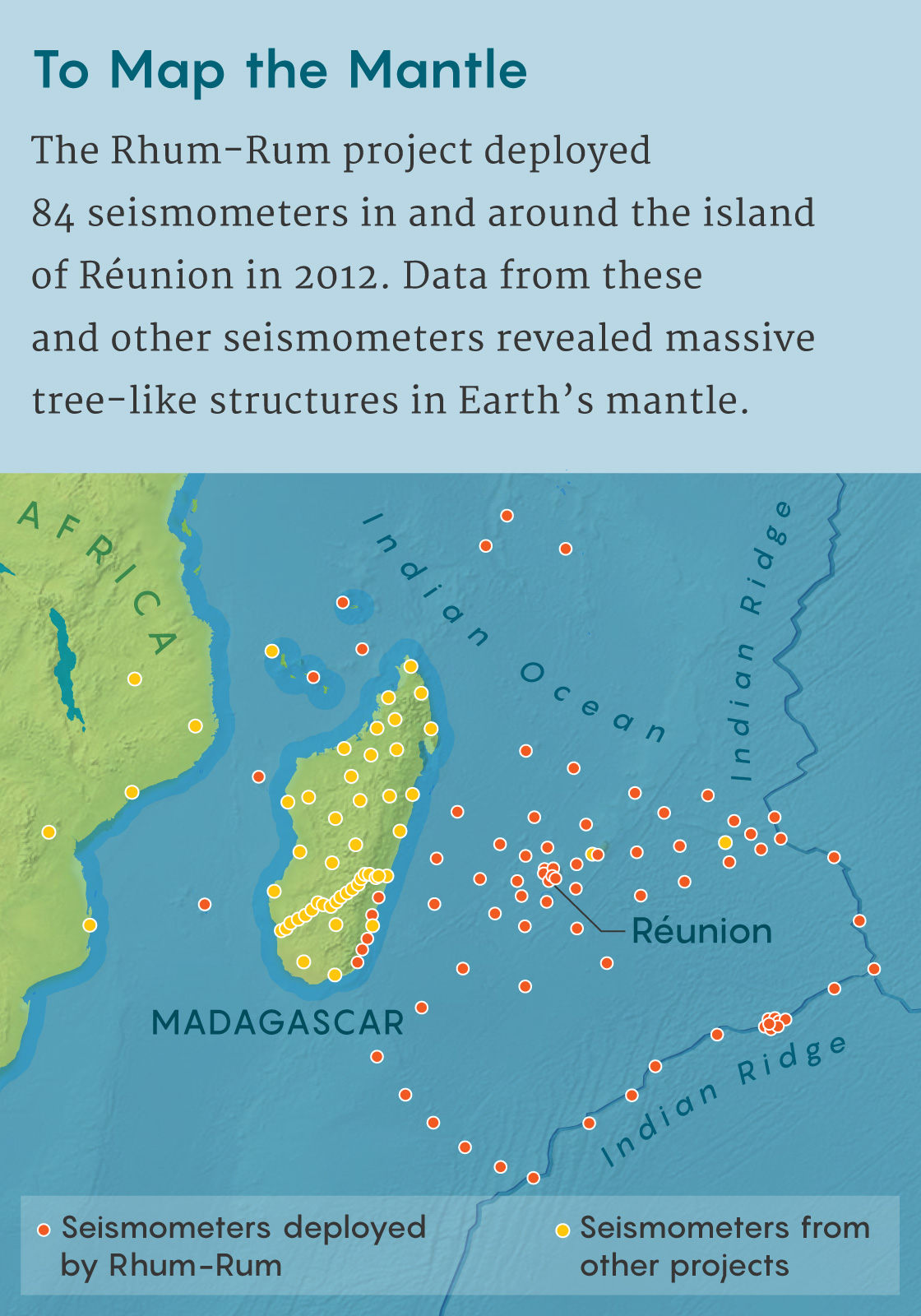
Samuel Velasco/Quanta Magazine; source: Rhum-Rum project
A team of scientists peered through their mantle telescope. They combined their data with two other seismic data sets, and they were shocked when they saw the thin, vertical plume beneath Réunion simply vanish in the lower mantle. At that moment, Maria Tsekhmistrenko, then a student of Sigloch’s at the University of Oxford, recalls thinking, “Oh, I must have done something terribly wrong. Everything is wrong. My Ph.D. is over.”
But as the team looked at the entire region, the data began to reveal a spectacular sight. The African giant blob, 2,900 kilometers below the surface, grows up from its middle to form a “trunk,” reaching a depth of 1,500 kilometers. The top of the trunk, dubbed the cusp, appears to grow thick branches of hot matter from its western and eastern extremities. These grow diagonally upward until they reach a depth of 1,000 to 800 kilometers; at this point, the tops of these branches sprout vertically rising thin branches.
One of these thin branches reaches the underside of hyper-volcanic Réunion. Around 3,000 kilometers northwest, another diagonal branch stretches to East Africa, a region awash with volcanism and which prior seismic work has found to be home to one or perhaps two mantle plumes.
But there was a problem: this structure was difficult to reconcile with the laws of thermodynamics.
Plumes, being so hot and buoyant, rise quickly — at 10 times the speed of other mantle migrations, including the movement of plates. “The plumes are so quick. You don’t have time to tilt them” as they ascend, said Goes.
Tsekhmistrenko, Sigloch and company agree: Plumes rise straight up. The tree structure, then, is evidence for a more complex process going on in the mantle.
Here’s how they think it works: The African blob — including the trunk and cusp — gets heated by the core. The eastern and western peripheries of the hot cusp, surrounded by a large proportion of relatively cooler ambient mantle material, are considerably buoyant. Eventually, an 800-kilometer blob pinches off from each end; both rise vertically for tens of millions of years. Eventually, they reach the shallow boundary between the dense lower mantle and the less dense upper mantle. There, they spread out laterally. Several tails sprout off the top of them and rise vertically, forming those narrow towers classically referred to as plumes.
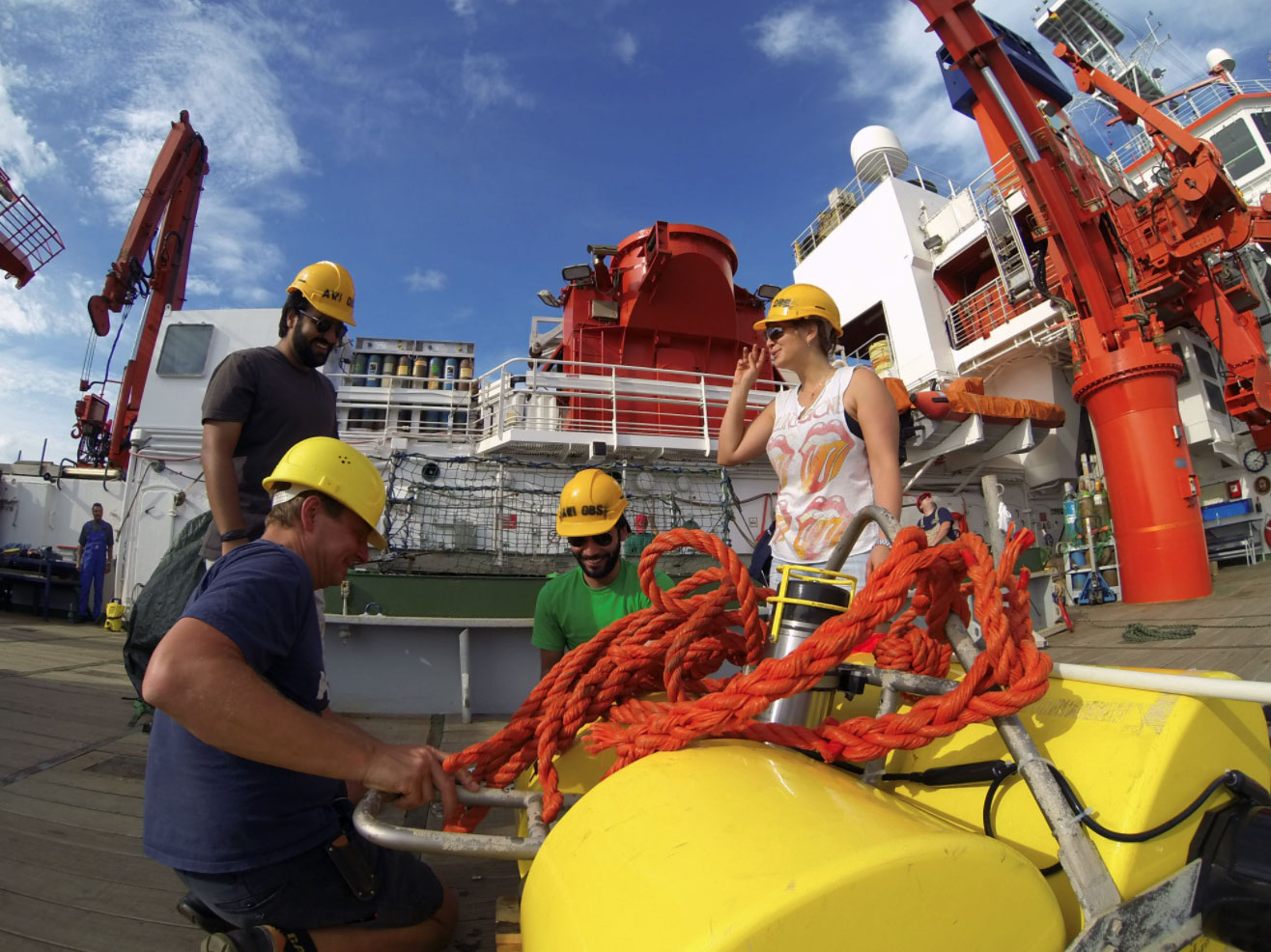
Maria Tsekhmistrenko (right) and other technicians during the month-long cruise to deploy 57 seismometers on the Indian Ocean seafloor in October 2012. The seismometers were retrieved a year later.
Guilhem Barroul
Meanwhile, as one of these two sub-blobs rises toward East Africa and one rises toward Réunion, the eastern and western extremities of the cusp — now closer to its middle — produce two new blobs, which also rise straight up. Since they leave later and are positioned to the lower right and lower left of the East African and Réunion blobs respectively, they resemble diagonal, interconnected branches. In reality, they are separate blobs, all rising vertically.
Independent scientists have largely applauded the research. Classically, the problem with imaging plume structures in high resolution is a lack of seismic data. Not so this time, said Rychert, “because they had this amazing experiment in the Indian Ocean,” one that gorged itself on a smorgasbord of seismic waves.
Combining the data from the giant array with additional seismic data sets proved instrumental, as it allowed the team to precisely resolve an entire swath of the mantle, from its greatest depths to its highest reaches. “In terms of the seismology, it is a step forward,” said Carolina Lithgow-Bertelloni, a geophysicist at the University of California, Los Angeles. “In that sense, I think it’s great.”
The tree structure is “an intriguing observation,” said Fitton, and the team’s model of how it branches up from the core is “quite a clever idea.” But he cautions that their precise model for what’s going on in the mantle is just one of several possible interpretations of what is happening. “I think that’s a really cool idea,” said Rychert. “I don’t know if it’s the right idea, but it’s cool.”
“Seismic tomography is a snapshot of today,” said Lithgow-Bertelloni. Taking snapshots of present-day structures and speculating on how they formed over millions of years, and how they will continue to evolve, is rife with uncertainty, she cautions.
The Cataclysms to Come
If the team’s theoretical model is correct, it bolsters two long-held trains of thought. The first, said Goes, is that Earth’s plumes are “not as simple as just making an upwelling in a box of syrup in a laboratory.” Nature is complex, and in oft-surprising ways.
The second is that these giant blobs have played, and will continue to play, a pivotal role in the planet’s tumultuous history.
Some scientists suspect that plumes from the African giant blob spent at least 120 million years tearing the ancient supercontinent of Gondwana into shards. As the plumes rose into its base, they heated it and weakened it; like moles making hills, they caused the land atop these plumes to dome upward, then slide downhill. Australia was unzipped from India and Antarctica, Madagascar from Africa, and the Seychelles microcontinent from India — an act of destruction that made the Indian Ocean.
Should the plume or plumes beneath East Africa sustain their onslaught, they will contribute to the future disintegration of the African continent: specifically, the breakup of East Africa and the creation of a new microcontinent floating beside the world’s youngest ocean.
But that future tectonic divorce seems insignificant when you consider the catastrophe that may befall the continent’s southern tip. The team estimates that, in tens of millions of years, a blob of nightmarishly gargantuan proportions will pinch off from the central cusp and rise to meet what is now South Africa’s foundations. This, said Sigloch, would produce cataclysmic eruptions. The Deccan Traps were caused by what we would think of as a solitary mantle plume. This future mega-blob, though, would be capable of producing volcanism so prolific and extensive that the Deccan Traps would be a firecracker in comparison.
Envisioning future volcanic apocalypses may be disquieting. But that is precisely why painting precise pictures of plumes matters: they are arbiters of life and death.
And yet, for all the chaos they cause, they are a key part of the unceasing cycle of plate tectonics, one that erratically buries and erupts carbon and water and has, miraculously, resulted in a habitable planet with a breathable atmosphere and expansive oceans — a paradise made by abyssal behemoths. “Knowing how a planet manages to do this for billions of years to basically allow human existence is important,” said Rychert.
It will be some time yet before the mantle’s monsters are thoroughly understood. Until that day arrives, scientists will keep sketching out the shape-shifting mantle, all the while listening to the many beasts stirring far below their feet.

